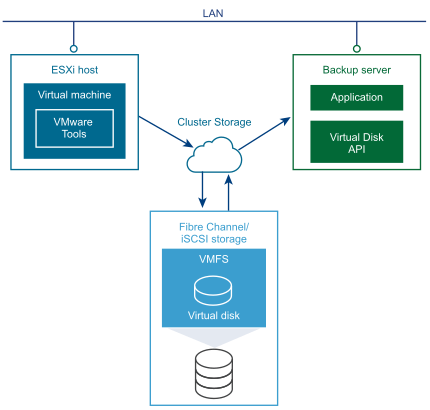SAN mode requires applications to run on a backup server with access to SAN storage (Fibre Channel, iSCSI, or SAS connected) containing the virtual disks to be accessed. As shown in the figure below, this method is efficient because no data needs to be transferred through the production ESXi host. A SAN backup proxy must be a physical machine. If it has optical media or tape drive connected, backups can be made entirely LAN-free.
In SAN transport mode, the virtual disk library obtains information from an ESXi host about the layout of VMFS LUNs, and using this information, reads data directly from the storage LUN where a virtual disk resides. This is the fastest transport method for software deployed on SAN-connected ESXi hosts.

In general, SAN transport works with any storage device that appears at the driver level as a LUN (as opposed to a file system such as NTFS or EXT). SAN mode must be able to access the LUN as a raw device. The real key is whether the device behaves like a direct raw connection to the underlying LUN. SAN transport is supported in Fibre Channel, iSCSI, and SAS based storage arrays (SAS means serial attached SCSI). SAN storage devices can contain SATA drives, but currently there are no SATA connected SAN devices on the VMware hardware compatibility list.
SAN transport is not supported for backup or restore of virtual machines residing on vVol datastores.
VMware vSAN, a network storage solution with host-attached disks, does not support SAN transport. Because vSAN has modes that are incompatible with SAN transport, if the virtual disk library detects vSAN storage, it deactivates SAN transport. Other transport modes do work.
By design, vSAN ESA (express storage architecture) makes a VMDK read-only when it has a snapshot. Do not attempt to restore virtual disks on vSAN ESA if they have snapshot(s).